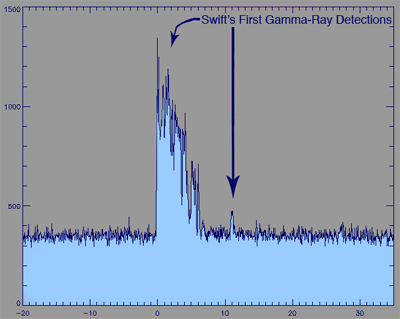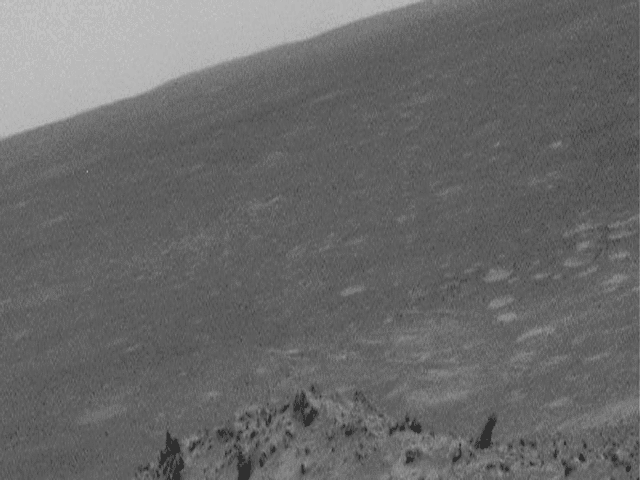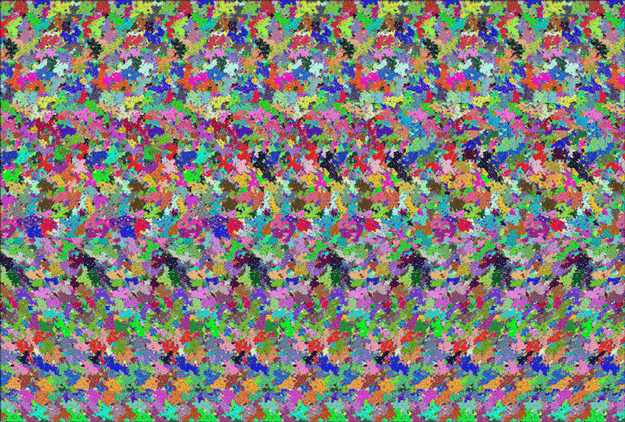|
To date, all of the ideas involving short-duration GRBs remain strictly theoretical. Much more observational work is
needed -- a detailed study of an afterglow will enable astronomers to pinpoint how far away short-duration GRBs are. Only
then will astronomers be able to glean important clues from explosions that are thought to be the biggest in the observable
Universe since the "explosion" of the Big Bang itself 13.7 billion years ago.  The first gamma-ray burst detected by Swift's Burst Alert Telescope was seen on December 11, 2004, beginning at 23:57 (UT).
Time is measured on the X-axis; the number of gamma-ray photons is measured on the Y-axis. This chart captures the essence
of the gamma-ray burst mystery -- a sudden rush of gamma rays lasting only about 7 seconds, coming seemingly from nowhere
and disappearing forever. I am awed by short grb's, I even like that no-one can positively identify
their source, which tends to make them even more mysterious. With limited knowledge of M theory and the holographic principle,
but with lots of imagination, I wonder if theories not mentioned by Mr. Hawkings et al could include: membrane activity, or
extra-dimensional interference. Merging black holes (as suggested by some) on a daily basis just doesn't seem like a reasonable
scenario. I was hoping you could keep me on an email list for reports as they become available. thanks mike
as I have written before and I would be thrilled if you post it is in the holgraphic principle there remains a higher
dimension that explains why we can calculate facts about black holes. My theory suggests that this greater dimension may be
interferring causing short grbs, also I have suggested possible brane interference grb.sonoma.edu GRBs appear to be divided into two classes: those shorter than 2 seconds, and those longer than 2 seconds. If this classification
scheme is correct, then it would follow that there are two different causes for the bursts. However, there are other properties
of the bursts which differ and could lead to alternative explanations. The jury is still out as to the classification scheme
and the associated mechanisms, especially for the shorter class of bursts SGR 1806-20 Blast I noticed that seconds after the initial blast of light, a doppler-like wave emanated from
that point and seemed to fly past the SWIFT camera. This "wave" appeared to be traveling at close to light speed, what was
it's composition? Referring Page: http://swift.sonoma.edu/resources/multimedia/images/
Answer provided by Lynn Cominsky (SSU E/PO Director):
The wave in question represented the light coming from the SGR
in the initial blast. The animation showed it as coming out afterwards, this was incorrect.
A common event often mistaken by people in the sky to be a Gamma-Ray burst is an Iridium Flare. If you visit this link
http://www.heavens-above.com, then put in your latitude and longitude, you will be able to see if there were any of these flares reported during this
time.
Fomalhaut, a 200-million-year-old
star, is a mere infant compared to our own 4.5-billion-year-old Sun. It resides 25 light-years away from the Sun. Located
in the constellation Piscis Austrinus (the Southern Fish), the Fomalhaut ring is ten times as old as debris disks seen previously
around the stars AU Microscopii and Beta Pictoris, where planets may still be forming. If our solar system is any example,
planets should have formed around Fomalhaut within tens of millions of years after the birth of the star. The Hubble images also provide a glimpse of the outer planetary region
surrounding a star other than our Sun. Many of the more than 100 planets detected beyond our solar system are orbiting close
to their stars. Most of the current planet-detecting techniques favor finding planets that are close to their stars. "The size of Fomalhaut's dust ring suggests that not all planetary
systems form and evolve in the same way — planetary architectures can be quite different from star to star," Kalas explained.
"While Fomalhaut's ring is analogous to the Kuiper Belt, its diameter is four times greater than that of the Kuiper Belt."The astronomers used the Advanced Camera for Surveys' (ACS) coronagraph
aboard Hubble to block out the light from the bright star so they could see details in the faint ring.
A huge, billowing pair of gas and dust clouds is the super-massive
star Eta Carinae.
Even though Eta Carinae is more than 8,000 light-years away,
features 10 billion miles across (about the diameter of our solar system) can be distinguished. Eta Carinae suffered giant
outburst about 150 years ago, when it became one of the brightest stars in the southern sky. Though the star released as much
visible light as a supernova explosion, it survived the outburst. Somehow, the explosion produced two lobes and a large, thin
equatorial disk, all moving outward at about 1.5 million miles per hour. Estimated to be 100 times heftier than our Sun, Eta
Carinae may be one of the most massive stars in our galaxy.


A Martian Dust Devil Passes
we are so fortunate that the general science community is so benevolent with their freedom to access all sorts of
wonderful information. This awesome NASA pic is no exception. Moving pictures from the surface of Mars...?

Our Business Philosophy
Our mission statement..... A Hitchhiker's Guide to the Moon  Imagine trekking in a lunar rover across miles of the Moon's rough surface. Your mission: to explore a crater with suspected
deposits of ice. Image left: When traveling on the Moon, don't forget your map!
Ion Thrusters Propel NASA into Future
|
05.27.05
|
We are a curious species with amazing capacities to imagine and dream. We wonder
about what we cannot see, are fascinated by what we do not know and are driven to explore.
In keeping with our continuous
quest for knowledge, President George W. Bush announced a new plan for NASA in Jan. 2004. A renewed focus on space exploration,
he explained, would strengthen our leadership in the world, improve our economy and enhance the quality of our lives.
 The Vision for Space Exploration calls for human and robotic missions to the Moon, Mars and beyond. To realize these ambitious
goals, we will need more powerful and efficient propulsion and power-generation systems -- systems that can thrust a spacecraft
out of Earth's orbit to the far reaches of the Universe. The Vision for Space Exploration calls for human and robotic missions to the Moon, Mars and beyond. To realize these ambitious
goals, we will need more powerful and efficient propulsion and power-generation systems -- systems that can thrust a spacecraft
out of Earth's orbit to the far reaches of the Universe. |
|

 The first gamma-ray burst detected by Swift's Burst Alert Telescope was seen on December 11, 2004, beginning at 23:57 (UT).
Time is measured on the X-axis; the number of gamma-ray photons is measured on the Y-axis. This chart captures the essence
of the gamma-ray burst mystery -- a sudden rush of gamma rays lasting only about 7 seconds, coming seemingly from nowhere
and disappearing forever.
The first gamma-ray burst detected by Swift's Burst Alert Telescope was seen on December 11, 2004, beginning at 23:57 (UT).
Time is measured on the X-axis; the number of gamma-ray photons is measured on the Y-axis. This chart captures the essence
of the gamma-ray burst mystery -- a sudden rush of gamma rays lasting only about 7 seconds, coming seemingly from nowhere
and disappearing forever.




 Imagine trekking in a lunar rover across miles of the Moon's rough surface. Your mission: to explore a crater with suspected
deposits of ice.
Imagine trekking in a lunar rover across miles of the Moon's rough surface. Your mission: to explore a crater with suspected
deposits of ice.  The Vision for Space Exploration calls for human and robotic missions to the Moon, Mars and beyond. To realize these ambitious
goals, we will need more powerful and efficient propulsion and power-generation systems -- systems that can thrust a spacecraft
out of Earth's orbit to the far reaches of the Universe.
The Vision for Space Exploration calls for human and robotic missions to the Moon, Mars and beyond. To realize these ambitious
goals, we will need more powerful and efficient propulsion and power-generation systems -- systems that can thrust a spacecraft
out of Earth's orbit to the far reaches of the Universe.